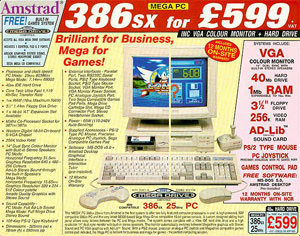AndyC wrote: ↑Tue Oct 18, 2022 5:39 pm
The Amstrad joystick port was basically Atari standard, there was a bit of a quirk in the way the second joystick was designed to be daisy chained but nothing as weird as the Sinclair ports on the +2 onwards.
You mean the Amstrad CPC joystick port…
I think the way the +2 ports were wired was intentional, as there are too many differences for it to be a botched job…
spider wrote: ↑Tue Oct 18, 2022 1:14 pm
The only thing I've always wondered about (I've not read the whole topic yet sorry) is -why- the first 'Amstrad' produced model aka the +2 was grey not black ?
What colour was the CPC range?
Did using that colour of ABS plastic save money or was it because Amstrad’s suppliers had plenty of it in stock (the plastic that the cases are made from)?
I’m amused by this topic. Sinclair and Amstrad were the king of cheap electronics (mainly audio gear) before computers were even thought of in the U.K. market. And had been in competition with each other before.
Amstrad were actually rather late in the market with the CPC 464.
Heat is not a factor in how reliable a ZX Spectrum is (well, apart from speeding up the process of the keyboard membrane tails cracking due to going brittle).
The main problems with the issue one and issue two rubber key machines was the poor quality control at the actual factory which was of course owned and operated by Timex. This was the first mass produced electronic production line that they been involved with. There was also a design limitation with the internal DC/DC converter circuitry, which can’t cope with an out of specification (as in too high) DC input voltage.
Later problems were due to edge-connector abuse. Now, failure of DRAM chips is quite common. The 4116 (or equivalent) DRAM has become increasingly unreliable. Other computers that use this type of DRAM are also affected. The ‘half working’ 32k DRAM in some machines may also be more likely to fail, even though it was fine in the 1980s. The fully working 64k DRAM (and later DRAM) chips also sometimes fail, but not as often.
Sinclair rubber key and plus machines made by Samsung appear to have reasonable reliability. As do other issue boards/machine once Timex sorted out their quality control.
And of course Amstrad had some production of +2 machines in the Far East, and I think all +2A/+2B/+3/+3B were made overseas. But some of the Amstrad +2 machines were made by Timex in the U.K….
The board in a ZX Spectrum+ is exactly the same as used in later versions of the rubber key. The only improvement being the case and keyboard.
The 128K fixed a lot of the design problems that Sinclair chose not to fix in the 16K/48K models. Unfortunately, they also introduced some new design problems.
The +2 is effectively the components from the 128K on a new design of board, with the chip from the interface 2 added (to provide the joystick ports). Obviously the keyboard is new, but based on combination of the multiple layer ZX Spectrum+ membrane and the existing CPC keyboard mechanism.
The +2A/+3 are reengineered designs, the idea being to cut costs (the gate array does more than the ULA did). The gate array also enables the keyboard membrane to go back to being a ‘single’ layer type (which is cheaper). Because (1) this design uses less chips, later (and hence more reliable) DRAM and there is less need for joystick interfaces, it is likely to be more reliable.
It’s also possible that even if Amstrad had not produced a reengineered design, once ULA production stopped, that would have been it.
With respect to what had happened if Amstrad had not bought the Sinclair computer operation (which at the time was only the ZX Spectrum and QL), it’s all speculation. Sinclair may have found someone else to help, or the company (Sinclair Research Ltd) could have folded with Sinclair setting up another company (something he did before). Keep in mind that the company was not called Sinclair Research Ltd during the time of the ZX80.
Did Amstrad keep the Spectrum scene alive? Absolutely yes. Did they innovate? Not so much. Should they have tried to expand or improve the machine further than including built in tape deck / disk drive / joystick ports / printer port? Not to pour water on the fire, but no, not really. That would have pushed the price up. Then the new machine would have been competing with the CPC range and the 16/32 bit Atari STFM computers for example.
In terms of evolution, all single board home computers (which the Spectrum 16K/48K is {not including the issue one board & DRAM expansion board}) were not really designed to have later expanded or improved models. They were designed for the market at the time. When technology improved, you were supposed to buy a new model and new software.
If anything, the sheer size of the ZX Spectrum software catalogue changed that. The same thing happened with the Commodore 64. It’s this that made the continuing production of both these home computers possible.
Mark